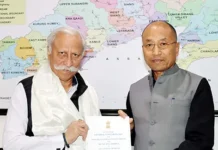On oral histories of ‘The Legends of Pensam’
[ Dr Doyir Ete Taipodia ]
In societies without written records, storytellers, rhapsodists, and shamans play vital roles. They preserve collective memory, document history, and are storehouses of indigenous knowledge. The Western preference for written records as truth and authenticity is being challenged, especially in non-Western cultures where oral traditions are deeply rooted in social and cultural traditions.
In oral tradition, history encompasses more than just individuals who have lived notable or powerful lives. Storytellers or rhapsodists record every member of the village or community and are familiar with each family’s history in a village. As a result, oral history also chronicles the lives of ordinary people — those on the periphery and living ‘in-between’, recounting their equally profound and meaningful experiences. It is such stories and lives that we come across in the book The Legends of Pensamby Mamang Dai. She is one of Arunachal’s most renowned authors. She received the Padma Shri in 2011, the Verrier Elwin Prize in 2013, and the Sahitya Akademi Award in 2017. Her novels traverse various themes and settings: from personal and local concerns in The Legends of Pensam(2006), to an urban setting in Stupid Cupid (2008), to historical fiction in The Black Hill (2014), and contemporary issues in Escaping the Land(2021). Throughout her works, Dai explores the lives of the people and their land, particularly the Adis. She has played a crucial role in introducing literature from Arunachal Pradesh to a global audience, thereby opening new doors for readers worldwide to discover our state.
In her book The Legends of Pensam, Dai explains the meaning of ‘pensam’, the central motif of the novel: “In our language, the language of the Adis, ‘pensam’ means ‘in-between’. It represents both the middle ground and the hidden spaces of the heart where a secret garden thrives.”
The book in itself occupies a unique literary space that defies easy categorisation. It is a novel with autobiographical elements, written in prose-poetry that resembles a beautiful song. The stories curated in the book are tales from ‘in-between’ spaces —between the nuances of lived experience, the intersections of joy and sorrow, the thresholds between life and death, and the moments between meetings and partings. These narratives are told through multiple voices and characters, shaped by the author’s personal experiences. The book sensitively depicts a variety of concerns, perspectives, and visions regarding the past, present, and future journeys of its characters.
In this writing, I aim to emphasise how oral material serves as a powerful tool for narrating stories rooted in oral histories and collective memories. I view narrators like Dai as modern-day rhapsodists, gifted with a keen perception of society’s nuances, its subtleties and a knack for exploring creative possibilities. Through their abilities, they create narratives that are compelling and leave a lasting impression. Oral stories are treasures entrusted to communities for safekeeping. Stories also foster a sense of unity and belonging within community members. Therefore, these stories must be shared responsibly and preserved for future generations. In such endeavours, narrators and scholars have animportant role to play.
In oral narration, listening attentively and grasping the essence of the storyteller’s message, intentions, and ancestral memories is essential. In The Legends of Pensam, this interpersonal relationship between the narrator and the characters is clearly evident. Dai’s use of multiple narrators, men and women of various ages, makes the stories inclusive and empathetic. Another notable aspect of the book is its use of the autobiographical paradigm. However, the term ‘autobiography’ falls short because Dai’s narrative framework is broader, focusing on “writing the story of me and my people,” making it more inclusive and comprehensive than a traditional autobiography. The narrator is the first person ‘I’. However, the first-person narrator mostly serves as a silent and passive observer and listener, allowing community storytellers to narrate their own stories from their unique perspectives.
The novel The Legends of Pensam seamlessly weaves oral traditions into its narratives. Dai’s storytelling techniques, character development, and thematic exploration show how her own cultural and personal experiences are incorporated into the book. For example, the first chapter, titled ‘The Boy who FellFrom the Sky’, narrates the story of Hoxo, the boy who is simply known as “the boy who fell from the sky.” He could never recall the events before that journey when his father Lutor, the chief of the Ido clan, brought him home in a basket. His story is similar to many other stories found in oral histories, where tales are recounted, and passed down, yet their origins often remain shrouded in the past like a shadowy mist. Similar is the case with many migration stories of different tribes. The beginnings of these migrations, the starting points of ancestor’sjourneys to their present locations, are frequently veiled in mystery and ambiguity.
Another example is the story of the legendary water serpent Biribik, whose appearance in dreams led to Lutor’s death. The strict hunting rules of Kiruk, if not followed correctly, can lead to accidents and fatalities. Additionally, there are tales of the river woman, the curious case of Kalen, and the story of Pinyar the Widow. These narratives, narrated by both men and women who have lived through and witnessed these events, provide insights into the socio-cultural worldview of the Adi tribe. They also reflect the author’s personal observations of the values and beliefs that shape her community and its worldview.
In the chapter ‘Songs of the Rhapsodist’, the author presents a Ponung dance. The dance and songs of the Ponung — their cadence, rhythm, steps, lamentations, romance, and stirring emotions — are beautifully translated into the written word. Dai describes how myth and memory come alive in the songs of the Ponung dancers, who sing into collective memory the tragic story of Komsing village, Noel Williamson, and his companions.
The stories also illustrate how the Adi society, represented by each character, navigates changing times — adapting to modern demands while preserving many traditions and practices. These narratives span across generations, portraying the evolution of Adi society over time. Dai discusses roads as a double-edged sword of development, the declining influence of the Kebang, the influx of migrants, and many other concerns that natives grapple with as they face the onslaught of inevitable changes. She writes about how villages are fighting a grim battle, surrendering ancestral lands for development projects like roads, and questions what these changes will bring them. Many villagers wonder how they will survive these winds of change.The ‘legends’ in The Legends of Pensam are tales of ordinary people living their lives according to their understanding of it. It is an exploration of lives lived in ‘pensam’. As Rakut, a character, aptly puts it, “We are peripheral people, just thinking out our thoughts.”
In The Legends of Pensam Dai incorporates oral stories, imbuing them with her personal perspective. Her personal connection to these narratives enables vivid descriptions of landscapes, characters, and events, drawing readers into the world of the Adi tribe. She emphasises, “It was important to record our stories. The old rhapsodists were a dying breed, and when they are gone, who would remember?” Viewing this book through this lens illustrates how oral narratives can be woven into contemporary literature, showcasing their role as a powerful tool in literary and creative writing as well as ensuring the survival of such stories. (Dr Doyir Ete Taipodia is Assistant Professor, English Department, RGU, and a member of the APLS and the Din Din Club)



